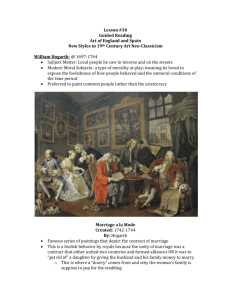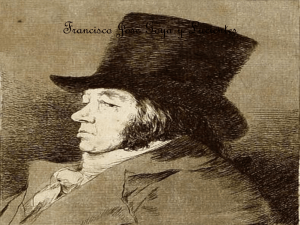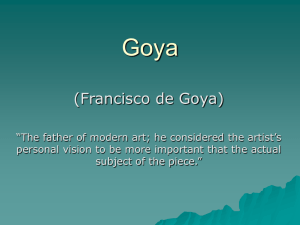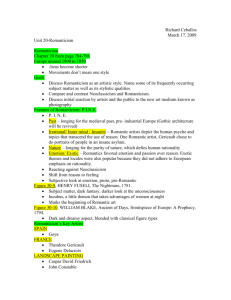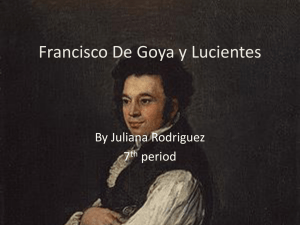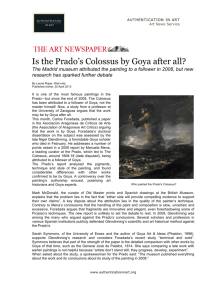Franciso goya
advertisement
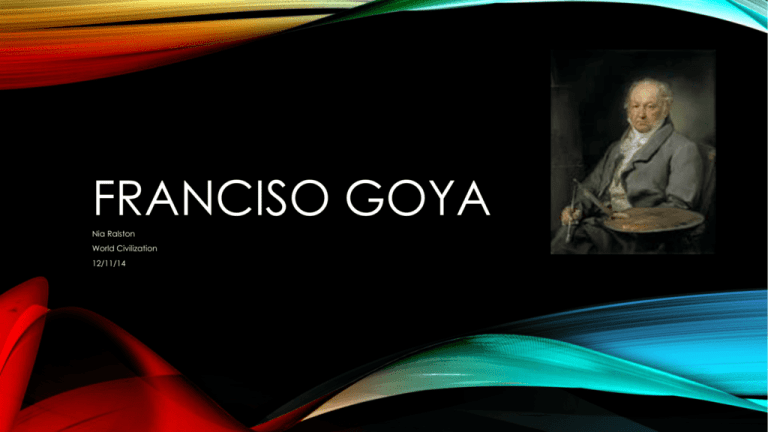
FRANCISO GOYA Nia Ralston World Civilization 12/11/14 QUESTIONS Who is he? Family Tree What was his illness? What was his position? What are his works? How was he important to the Enlightenment? Most famous work today WHO IS HE? The son of a guilder, Goya spent some of his youth in Saragossa. There he began studying painting around the age of fourteen. He was a student of José Luzán Martínez. At first, Goya learned by imitation. He copied the works of great masters, finding inspiration in the works of such artists as Diego Rodríguez de Silva y Velázquez and Rembrandt van Rijn. Later, Goya moved to Madrid, where he went to work with brothers Francisco and Ramón Bayeu y Subías in their studio. He sought to further his art education in 1770 or 1771 by traveling to Italy. In Rome, Goya studied the classic works there. He submitted a painting to a competition held by the Academy of Fine Arts at Parma. While the judges liked his work, he failed to win the top prize. WHAT WAS HIS ILLNESS? In 1792, Goya became completely deaf after suffering from an unknown malady. When Goya was forty-six, in 1792, he contracted a mysterious illness that left him incapacitated. We know from his letters to close friends that his vision went blurry, he suffered from comas and partial paralysis, and he struggled with bouts of dizziness and hearing loss. After the illness left him deaf, his interior world had to feed itself on light and shadow and emotions, and it began to populate itself with feelings, longings, and ghosts. Goya became more withdrawn and introspective and his vitality was directed entirely to his painting. WHAT WAS HIS POSITION? Ferdinand reportedly once told Goya that "You deserve to be garroted, but you are a great artist so we forgive you." Others in Spain were not so lucky as the king sought to crackdown on liberals who sought to make the country a constitutional state. Despite the personal risks, Goya expressed his dissatisfaction with the Ferdinand's rule in a series of etchings called "Los disparates." These works featured a carnival theme and explored folly, lust, old age, suffering and death among other issues. With his grotesque imagery, Goya seemed to illustrate the absurdity of the times. The political climate subsequently became so tense that Goya willingly went into exile in 1824. Despite his poor health, Goya thought he might be safer outside of Spain. Goya moved to Bordeaux, France, where he spent the remainder of his life. During this time, he continued to paint. Some of his later works included portraits of friends also living in exile. Goya died on April 16, 1828, in Bordeaux, France. WHAT ARE HIS WORKS? http://www.franciscodegoy a.net/slideshow.html HOW WAS HE IMPORTANT TO THE ENLIGHTENMENT? • the most important Spanish artist of the late eighteenth and early nineteenth centuries. Over the course of his long career, Goya moved from jolly and lighthearted to deeply pessimistic and searching in his paintings, drawings, etchings, and frescoes. The Bourbon monarchy was restored with Napoleon's fall in 1814. But the new king, Ferdinand VII, son of Charles IV, did not share the enlightened views of his predecessor. He revoked the Constitution, reinstated the Inquisition, and declared himself absolute monarch. Not long afterward, he launched a reign of terror. Questioned about his loyalty to the occupiers, Goya demonstrated his allegiance by commemorating Spain's uprising against the French regime in two paintings: The Second of May 1808 and The Third of May 1808. http://www.franciscodegoya.net
